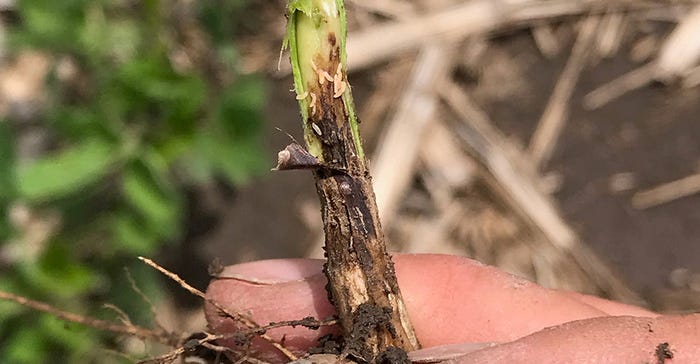
An invasive insect that causes soybean farmers to lose all yield within the field’s first 100 feet is in Missouri.
Soybean gall midge is a pest to watch, says Kevin Rice, University of Missouri Extension entomologist. The origin of the species is unknown. It was first reported in 2011 in northeast Nebraska on damaged and diseased plants on a few farms; however, University of Nebraska researchers do not know if it is the same species farmers see today. There were no samples taken or genetically tested at that time.
The soybean gall midge belongs to the same family as the Hessian fly and wheat midge, which are primarily pests in wheat, and was initially only identified to genus. Entomologists from neighboring states, such as South Dakota and Nebraska, monitored the pest and began seeing rapid widespread damage in 2018. And then soybean gall midge was described as a new species.
In 2019, this gall midge was found in Atchison County in Missouri. A year later, it was detected in Holt County. “We do expect it to spread throughout the state,” Rice warns, while speaking at the virtual MU Crop Management Conference.
Detect gall midge
Soybean growers will most likely not see the gall midge flying around in the field. Even university researchers struggle to capture them with sweep nets. So, it is hard to track the insect’s movement.
For many, the initial sign of soybean gall midge is the darkening of soybean plants at the ground level. “It sort of looks like one of those fungal pathogens at the base,” Rice explains.
Farmers who see dark black or brown on the soybean plant stem should break them at the base and peel back the epidermis. Rice says if there are bright orange larvae underneath, they are soybean gall midges.
Close up when the larvae first hatches, this gall midge is semi-translucent and white. When it gets into later instars, Rice says, the pest become a bright orange color. “They are easy to see. They kind of stand out, and we don't have anything else that really looks like this," he says.
And the damage to soybean yield is from the larvae.
Yields destroyed
Unfortunately, Rice says, it looks like all vegetative and reproductive stages of soybeans are susceptible to gall midge damage.
“It does have an edge species characteristic, so that’s where we've seen the worst-case scenarios,” he explains. “We had 100% losses along the first 100-foot edge of soybeans, and then 20% losses in the second hundred feet. So, that's pretty severe losses in a field when you go around the entire border.”

Soybean gall midge feeding on a plant along the edges results in complete yield loss. It cuts off nutrient and water supply to the plant. There is no treatment for this invasive pest.
The soybean gall midge is feeding on the plant stem underneath and reducing the nutrient flow while increasing water loss. When several larvae are feeding on one plant, it eventually becomes brittle and then it snaps, and there is 100% yield loss.
Research in the past couple of years shows that there are multiple generations per year for this invasive pest. “So, because there's multiple generations, overlapping generations, the adults are coming out over several weeks, and they're laying eggs and then the larvae are protected from foliar insecticides,” Rice explains. So the damage to yield continues.
Evading treatment
Rice says there are no current control options for soybean gall midge in Missouri.
“We do know that seed treatments, unfortunately, don't look like they work very well against soybean gall midge because it attacks soybeans a little later in the season,” he says. “After that, insecticide is already out of the plant.”
As far as foliar insecticides, while they would kill the adult soybean gall midge, farmers would have to spray multiple times throughout the growing season, and Rice says it is just not economical.
The University of Missouri is working with a larger research program to find control options for soybean gall midge through the soybean checkoff. The group is looking at insecticide treatments and timing based on the emergence of the pest.
In the meantime, Rice asks farmers to report any soybean gall midge sightings to their local Extension office. “If you find something, if you need help identifying it, you can bag it or take a picture,” he says. However, do not send it to Rice. “We don’t want to spread it," he says.
Farmers can email photos to [email protected]. Rice will work with local Extension staff to identify the pest.
Researchers need these reports to track soybean gall midge movement and establish side-by-side treatment trials. Rice adds by working together, there is hope to find farmers some control options for this invasive species.
About the Author(s)
You May Also Like






